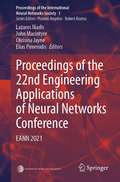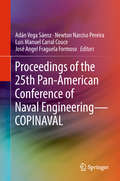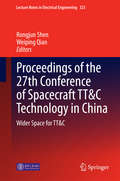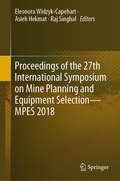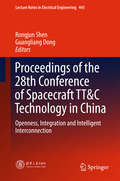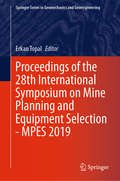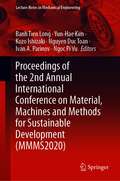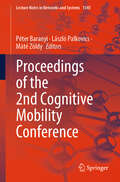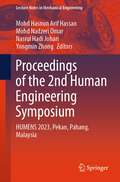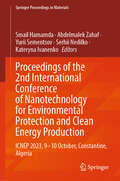- Table View
- List View
Proceedings of the 22nd Engineering Applications of Neural Networks Conference: EANN 2021 (Proceedings of the International Neural Networks Society #3)
by Elias Pimenidis Chrisina Jayne Lazaros Iliadis John MacintyreThis book contains the proceedings of the 22nd EANN “Engineering Applications of Neural Networks” 2021 that comprise of research papers on both theoretical foundations and cutting-edge applications of artificial intelligence. Based on the discussed research areas, emphasis is given in advances of machine learning (ML) focusing on the following algorithms-approaches: Augmented ML, autoencoders, adversarial neural networks, blockchain-adaptive methods, convolutional neural networks, deep learning, ensemble methods, learning-federated learning, neural networks, recurrent – long short-term memory. The application domains are related to: Anomaly detection, bio-medical AI, cyber-security, data fusion, e-learning, emotion recognition, environment, hyperspectral imaging, fraud detection, image analysis, inverse kinematics, machine vision, natural language, recommendation systems, robotics, sentiment analysis, simulation, stock market prediction.
Proceedings of the 22nd International Conference on Industrial Engineering and Engineering Management 2015
by Ershi Qi Jiang Shen Runliang DouBeing the premier forum for the presentation of new advances and research results in the fields of Industrial Engineering, IEEM 2015 aims to provide a high-level international forum for experts, scholars and entrepreneurs at home and abroad to present the recent advances, new techniques and applications face and face, to promote discussion and interaction among academics, researchers and professionals to promote the developments and applications of the related theories and technologies in universities and enterprises, and to establish business or research relations to find global partners for future collaboration in the field of Industrial Engineering. All the goals of the international conference are to fulfill the mission of the series conference which is to review, exchange, summarize and promote the latest achievements in the field of industrial engineering and engineering management over the past year, and to propose prospects and vision for the further development. This volume is the first of the two proceedings volumes from this conference.
Proceedings of the 23rd Asia Pacific Symposium on Intelligent and Evolutionary Systems (Proceedings in Adaptation, Learning and Optimization #12)
by Hiroshi Sato Saori Iwanaga Akira IshiiThis book presents selected papers from the 23rd Asia Pacific Symposium on Intelligent and Evolutionary Systems (IES 2019), which was held in Tottori, Japan, on December 6–8, 2019.Today, various types of intelligent system can be found everywhere. However, none of them can be developed or understood from only one perspective. As such, this book collects unique ways of thinking about intelligent systems.It discusses evolutionary and complex adaptive systems, which have been useful approaches for tackling intelligent systems. It also examines the recent developments in the field of artificial intelligence that are driving research on intelligent systems.Addressing topics related to intelligent transport systems, machine learning and neural networks, data science and decision analytics, evolutionary and nature-inspired computation, and agents and complex systems, this book is a valuable resource for researchers and practitioners wanting to develop or understand intelligent and evolutionary systems.
Proceedings of the 23rd Pacific Basin Nuclear Conference, Volume 1: PBNC 2022, 1 - 4 November, Beijing & Chengdu, China (Springer Proceedings in Physics #283)
by Chengmin LiuThis is the first in a series of three volumes of proceedings of the 23rd Pacific Basin Nuclear Conference (PBNC 2022) which was held by Chinese Nuclear Society. As one in the most important and influential conference series of nuclear science and technology, the 23rd PBNC was held in Beijing and Chengdu, China in 2022 with the theme “Nuclear Innovation for Zero-carbon Future”. For taking solid steps toward the goals of achieving peak carbon emissions and carbon neutrality, future-oriented nuclear energy should be developed in an innovative way for meeting global energy demands and coordinating the deployment mechanism. It brought together outstanding nuclear scientists and technical experts, senior industry executives, senior government officials and international energy organization leaders from all across the world. The proceedings highlight the latest scientific, technological and industrial advances in Nuclear Safety and Security, Operations and Maintenance, New Builds, Waste Management, Spent Fuel, Decommissioning, Supply Capability and Quality Management, Fuel Cycles, Digital Reactor and New Technology, Innovative Reactors and New Applications, Irradiation Effects, Public Acceptance and Education, Economics, Medical and Biological Applications, and also the student program that intends to raise students’ awareness in fully engaging in this career and keep them updated on the current situation and future trends.These proceedings are not only a good summary of the new developments in the field, but also a useful guideline for the researchers, engineers and graduate students.This is an open access book.
Proceedings of the 23rd Pacific Basin Nuclear Conference, Volume 2: PBNC 2022, 1 - 4 November, Beijing & Chengdu, China (Springer Proceedings in Physics #284)
by Chengmin Liu“This is the second in a series of three volumes of proceedings of the 23rd Pacific Basin Nuclear Conference (PBNC 2022) which was held by Chinese Nuclear Society. As one in the most important and influential conference series of nuclear science and technology, the 23rd PBNC was held in Beijing and Chengdu, China in 2022 with the theme “Nuclear Innovation for Zero-carbon Future”. For taking solid steps toward the goals of achieving peak carbon emissions and carbon neutrality, future-oriented nuclear energy should be developed in an innovative way for meeting global energy demands and coordinating the deployment mechanism. It brought together outstanding nuclear scientists and technical experts, senior industry executives, senior government officials and international energy organization leaders from all across the world. The proceedings highlight the latest scientific, technological and industrial advances in Nuclear Safety and Security, Operations and Maintenance, New Builds, Waste Management, Spent Fuel, Decommissioning, Supply Capability and Quality Management, Fuel Cycles, Digital Reactor and New Technology, Innovative Reactors and New Applications, Irradiation Effects, Public Acceptance and Education, Economics, Medical and Biological Applications, and also the student program that intends to raise students’ awareness in fully engaging in this career and keep them updated on the current situation and future trends.These proceedings are not only a good summary of the frontiers in nuclear science and technology, but also a useful guideline for the researchers, engineers and graduate students.
Proceedings of the 23rd Pacific Basin Nuclear Conference, Volume 3: PBNC 2022, 1 - 4 November, Beijing & Chengdu, China (Springer Proceedings in Physics #285)
by Chengmin LiuThis is the third in a series of three volumes of proceedings of the 23rd Pacific Basin Nuclear Conference (PBNC 2022) which was held by Chinese Nuclear Society. As one in the most important and influential conference series of nuclear science and technology, the 23rd PBNC was held in Beijing and Chengdu, China in 2022 with the theme “Nuclear Innovation for Zero-carbon Future”. For taking solid steps toward the goals of achieving peak carbon emissions and carbon neutrality, future-oriented nuclear energy should be developed in an innovative way for meeting global energy demands and coordinating the deployment mechanism. It brought together outstanding nuclear scientists and technical experts, senior industry executives, senior government officials and international energy organization leaders from all across the world. The proceedings highlight the latest scientific, technological and industrial advances in Nuclear Safety and Security, Operations and Maintenance, New Builds, Waste Management, Spent Fuel, Decommissioning, Supply Capability and Quality Management, Fuel Cycles, Digital Reactor and New Technology, Innovative Reactors and New Applications, Irradiation Effects, Public Acceptance and Education, Economics, Medical and Biological Applications, and also the student program that intends to raise students’ awareness in fully engaging in this career and keep them updated on the current situation and future trends. These proceedings are not only a good summary of the new developments nuclear science and technology, but also a useful guideline for the researchers, engineers and graduate students.
Proceedings of the 25th International Symposium on Advancement of Construction Management and Real Estate
by Yi Peng Weisheng Lu Xinhai Lu Zuo ZhangThis proceedings book focuses on innovation, cooperation, and sustainable development in the fields of construction management and real estate. The book provides a detailed analysis and description of the disciplinary frontiers in the field of building management and real estate and how they can be promoted in the context of the epidemic. A wide variety of papers provide a reference value for both scholars and practitioners. The proceedings book is the documentation of “the 25th International Symposium on Advancement of Construction Management and Real Estate” (CRIOCM 2020), which was held at the School of Public Administration, Central China Normal University, Wuhan, China, in 2020.
Proceedings of the 25th Pan-American Conference of Naval Engineering—COPINAVAL
by Adán Vega Sáenz Newton Narciso Pereira Luis Manuel Carral Couce José Angel Fraguela FormosoThis book presents selected contributions to the Pan-American Congress of Naval Engineering, Maritime Transport and Port Engineering (COPINAVAL), which is in its twenty-fifth edition and has become a reference event for the global maritime and port sector, attracting more and more participants from different countries. The 2017 congress was held in Panama City, Panama, bringing together a select group of scientists, entrepreneurs, academics and professionals to discuss the latest technological advances in the maritime industry.
Proceedings of the 26th Australasian Conference on the Mechanics of Structures and Materials: ACMSM26, 3–6 December 2023, Auckland, New Zealand (Lecture Notes in Civil Engineering #513)
by Nawawi Chouw Chunwei ZhangThis book presents peer reviewed articles from The 26th Australasian Conference on the Mechanics of Structures and Materials (ACMSM26) held in December 2023 at the University of Auckland in New Zealand. Bringing together international experts and leaders to disseminate recent research findings in the fields of structural mechanics, civil engineering and materials, it offers a forum for participants from around the world to review, discuss, and present the latest developments in the broad discipline of mechanics and materials in civil engineering.
Proceedings of the 26th Conference of Spacecraft TT&C Technology in China
by Weiping Qian Rongjun Shen'Proceedings of the 26th Conference of Spacecraft TT&C Technology in China' collects selected papers from the 26th Conference of Spacecraft TT&C Technology in China held in Nanjing on October 16-19, 2012. The book features state-of-the-art studies on spacecraft TT&C in China with the theme of "Shared and Flexible TT&C Systems". The selected works can help promote the technologies in standardization, informatization, communication networks and intelligence. Researchers and engineers in the field of aerospace engineering and communication engineering can benefit from the book. SHEN Rongjun is the Academician of Chinese Academy of Engineering; QIAN Weiping is the Director General of Beijing Institute of Tracking and Telecommunications Technology.
Proceedings of the 26th International Symposium on Advancement of Construction Management and Real Estate (Lecture Notes in Operations Research)
by Yi Peng Weisheng Lu Hongling Guo Dongping FangThis book of CRIOCM 2021 (26th International Conference on Advancement of Construction Management and Real Estate) presents the latest developments in real estate and construction management around the globe. The conference was organized by the Chinese Research Institute of Construction Management (CRIOCM) working in close collaboration with Tsinghua University. Written by international academics and professionals, the book discusses the latest achievements, research findings and advances in frontier disciplines in the field of construction management and real estate. Covering a wide range of topics, including building information modeling, big data, geographic information systems, housing policies, management of infrastructure projects, intelligent construction and smart city, real estate finance and economics and urban planning and sustainability, the discussions provide valuable insights into the implementation of advanced construction project management and real estate market in China and abroad. The book offers an outstanding resource for academics and professionals.
Proceedings of the 27th International Conference on Systems Engineering, ICSEng 2020 (Lecture Notes in Networks and Systems #182)
by Henry Selvaraj Dawid Zydek Grzegorz ChmajThis book covers topics such as AeroSpace Systems, Intelligent Systems, Machine Learning and Analytics, Internet of Things, Applied Media Informatics and Technology, Adaptive Control Systems, Software Engineering and Cyber-Physical Systems. Research in the discipline of Systems Engineering is an important concept in the advancement of engineering and information sciences. Systems Engineering attempts to integrate many of the traditional engineering disciplines to solve large complex functioning engineering systems, dependent on components from all the disciplines. The research papers contained in these proceedings reflect the state of the art in Systems Engineering from all over the world and serve as vital references to researchers to follow. This book is a very good resource for graduate students, researchers and scholars who want to learn about the most recent development in the fields.
Proceedings of the 27th International Symposium on Advancement of Construction Management and Real Estate (Lecture Notes in Operations Research)
by Jing Li Yi Peng Weisheng Lu Hongping Yuan Daikun WangThis book presents the proceedings of CRIOCM 2022 (27th International Conference on Advancement of Construction Management and Real Estate), sharing the latest developments in real estate and construction management around the globe. The conference was organized by the Chinese Research Institute of Construction Management (CRIOCM) working in close collaboration with The Chinese University of Hong Kong. Written by international academics and professionals, the book discusses the latest achievements, research findings, and advances in frontier disciplines in the field of construction management and real estate. Covering a wide range of topics, including spatial planning and land use innovation, integration and application of BIM and GIS, low-carbon built environment, post-pandemic resilient cities development, housing and social governance, real estate market and urban policy, real estate finance and economics, intelligent construction and smart city, built environment for healthy living, and construction management in the post-COVID-19 era, the discussions provide valuable insights into the implementation of advanced construction project management and real estate market in China and abroad. The book offers an outstanding resource for academics and professionals
Proceedings of the 27th International Symposium on Mine Planning and Equipment Selection - MPES 2018
by Raj Singhal Eleonora Widzyk-Capehart Asieh HekmatThis proceedings book presents research papers discussing the latest developments and findings in the fields of mining, machinery, automation and environmental protection. It includes contributions from authors from over 20 countries, with backgrounds in computer science, mining engineering, technology and management, and hailing from the government, industry and academia. It is of interest to scientists, engineers, consultants and government staff who are responsible for the development and implementation of innovative approaches, techniques and technologies in the mineral industries. Covering the latest advances in fundamental research, it also appeals to academic researchers.
Proceedings of the 28th Conference of Spacecraft TT&C Technology in China
by Rongjun Shen Guangliang DongThis book collects selected papers from the 28th Conference of Spacecraft TT&C Technology in China held on November 8-10, 2016. The book features state-of-the-art studies on spacecraft TT&C in China with the theme of "Openness, Integration and Intelligent Interconnection". To meet requirements of new space endeavors, development of spacecraft instrumentation systems have to follow an open concept and approach in China. An open spacecraft instrumentation system encompasses integrated development of different types of services, integration of disciplines and specialties, intelligent links, and more scientific and intelligent information interface technology. Researchers and engineers in the field of aerospace engineering and communication engineering can benefit from the book.
Proceedings of the 28th International Cryogenic Engineering Conference and International Cryogenic Materials Conference 2022: ICEC28-ICMC 2022, Hangzhou, China (Advanced Topics in Science and Technology in China #70)
by Kai Wang Limin Qiu Yanwei MaThis book gathers selected papers from the 28th International Cryogenic Engineering Conference and International Cryogenic Materials Conference 2022 (ICEC28-ICMC 2022), held virtually in Hangzhou, China on 25-29 April 2022, due to COVID-19 pandemic. Highlighting the latest findings on cryogenic engineering and cryogenic materials, it covers topics including: large-scale cryogenic components, processes and systems for refrigeration, separation, and liquefaction of cryogenic fluids, small-scale cryocoolers, cryogenic space applications, thermal insulation, thermal-physical properties of cryogenic fluids and materials, superconducting materials, devices, systems and applications, etc. The book offers valuable information and insights for academic researchers, engineers in the industry, and operators in the cryogenic field.
Proceedings of the 28th International Symposium on Mine Planning and Equipment Selection - MPES 2019 (Springer Series in Geomechanics and Geoengineering)
by Erkan TopalThis conference proceedings presents the research papers in the field of mine planning and mining equipment including themes such as mine automation, rock mechanics, drilling, blasting, tunnelling and excavation engineering. The papers presents the recent advancement and the application of a range of technologies in the field of mining industry. It is of interest to the professionals who practice in mineral industry including but not limited to engineers, consultants, managers, academics, scientist, and government staff.
Proceedings of the 2nd Annual International Conference on Material, Machines and Methods for Sustainable Development (Lecture Notes in Mechanical Engineering)
by Ivan A. Parinov Ngoc Pi Vu Yun-Hae Kim Banh Tien Long Kozo Ishizaki Nguyen Duc ToanThis book presents selected, peer-reviewed proceedings of the 2nd International Conference on Material, Machines and Methods for Sustainable Development (MMMS2020), held in the city of Nha Trang, Vietnam, from 12 to 15 November, 2020. The purpose of the conference is to explore and ensure an understanding of the critical aspects contributing to sustainable development, especially materials, machines and methods. The contributions published in this book come from authors representing universities, research institutes and industrial companies, and reflect the results of a very broad spectrum of research, from micro- and nanoscale materials design and processing, to mechanical engineering technology in industry. Many of the contributions selected for these proceedings focus on materials modeling, eco-material processes and mechanical manufacturing.
Proceedings of the 2nd Cognitive Mobility Conference (Lecture Notes in Networks and Systems #1345)
by Péter Baranyi László Palkovics Máté ZöldyThis book features selected papers presented at the 2nd International Conference on Cognitive Mobility which took place on October 19-20, 2023, in Budapest, Bosch Innovation Campus. This conference brought together innovative research that explores the intersection of mobility, transportation, and social sciences, offering valuable insights for professionals in these fields. The proceedings encompass a diverse range of topics, including: Deep learning models for classification in mobility contexts. Vehicle engineering advancements. Social impacts of transportation systems. Designed for researchers, practitioners, and policymakers, this book serves as a vital resource for understanding and advancing cognitive mobility. They provide practical applications and theoretical frameworks that can enhance decision-making and innovation in transportation solutions.
Proceedings of the 2nd Energy Security and Chemical Engineering Congress: Selected Articles from ESChE 2021, Malaysia (Lecture Notes in Mechanical Engineering)
by Nasrul Hadi Johari Sudhakar Kumarasamy Wan Azmi Wan Hamzah Mohd Fairusham Ghazali Herma Dina SetiabudiThis book presents selected articles presented at the 2nd Energy Security and Chemical Engineering Congress (ESChE 2021). This collection of proceedings presents the key challenges and trends related to mechanical as well as materials engineering and technology in setting the stage for promoting the sustainable technological solution for the better world. The book discusses recent explorations and findings with regard to mechanical and materials, specifically the thermal engineering and renewable energy areas that are very relevant toward the establishment of sustainable technological solutions. This book benefits academic researchers and industrial practitioners in the field of renewable energy and material engineering for energy applications.
Proceedings of the 2nd Human Engineering Symposium: HUMENS 2023, Pekan, Pahang, Malaysia (Lecture Notes in Mechanical Engineering)
by Mohd Hasnun Arif Hassan Nasrul Hadi Johari Mohd Nadzeri Omar Yongmin ZhongThis book acts as a compilation of papers presented in the 2nd Human Engineering Symposium (HUMENS 2023), held at Pekan, Pahang, Malaysia. The symposium covers the following research topics: ergonomics, biomechanics, sports technology, medical device and instrumentation, artificial intelligence / machine learning, industrial design, rehabilitation, additive manufacturing, modelling and bio-simulation, and signal processing. The articles published will be of interest to researchers and practitioners from the medical device manufacturers, healthcare, rehabilitation and sports technology.
Proceedings of the 2nd International Civil Engineering and Architecture Conference: CEAC 2022, 11-14 March 2022, Singapore (Lecture Notes in Civil Engineering #279)
by Marco CasiniThis book collects the scientific proceedings presented during the “2022 The 2nd International Civil Engineering and Architecture Conference” held in Singapore in March 2022 with the aim of showing the latest advancements in theoretical and applied research in the architecture, engineering, and construction sector (AEC). The book is organized into 4 main parts, namely (1) Sustainable Urban Planning and Architecture; (2) Architectural and Environmental Design; (3) Built Environment Materials and Construction Technology; and (4) Civil Engineering and Construction Management. The goal of the book is to provide readers with an overview of the ongoing transformation of the AEC industry presenting a thorough investigation of the emerging trends in the fields of green building design, construction, and operation.
Proceedings of the 2nd International Conference Engineering Innovations and Sustainable Development (Lecture Notes in Civil Engineering #378)
by Valentina MantulenkoThis book presents the contributions from the 2nd International Conference Engineering Innovations and Sustainable Development, held in Samara, Russia on April 20–21, 2023. By presenting international research on various sustainability issues, it includes topics such as current trends in industrial and agricultural development, innovations in the construction and transport sectors, problems concerning the financing of innovative activities and governmental support for innovations, and engineering competences and skills in the era of new technologies. It also covers the economic, environmental, and informational aspects of sustainable development in the context of innovations. Finally, the book addresses theoretical and practical aspects by studying the phenomenon of sustainability and engineering development in terms of comparing international experiences. It provides significant value for scientists, teachers, and students of higher educational institutions, and specialists, who are researching sustainable development issues in the era of engineering innovations.
Proceedings of the 2nd International Conference for Smart Agriculture, Food, and Environment (Advances in Biological Sciences Research #25)
by Tofael Ahamed Nurul Huda Irwandi Jaswir Yayu Romdhonah Alimuddin Alimuddin Nidal NasserThis is an open access book.Agriculture, food, and environment are a measure of the availability of food and individuals’ accessibility to it, where accessibility includes affordability. Agriculture, food, and environment are a potential predicament to the world at this time. Today we are facing a challenge to provide inexpensive, sustainable, and nutritious food to the fast-growing world’s population. It includes a wide range of fundamental food issues. Therefore, it is our great pleasure to welcome you to the 2nd International Conference for Smart Agriculture, Food, and Environment. This Conference is organized by Center of Excellence For Local Food Innovation (CELOFI) Universitas Sultan Ageng Tirtayasa.
Proceedings of the 2nd International Conference of Nanotechnology for Environmental Protection and Clean Energy Production: ICNEP 2023, 9–10 October, Constantine, Algeria (Springer Proceedings in Materials #45)
by Smail Hamamda Abdelmalek Zahaf Yurii Sementsov Serhii Nedilko Kateryna IvanenkoThis proceedings book covers the latest research and advancements in nanotechnology for environmental protection and clean energy production. It encompasses a wide range of topics, including physical-chemical nanomaterials science, nanoscale physics, nanocomposites and nanomaterials applications, solids and structures, renewable energy, nanoparticles, and metallic and polymer materials. While focusing on scientific advancements, this book highlights the practical applications of nanotechnology in environmental protection and clean energy production. It bridges the gap between theory and real-world implementation, making it a valuable resource for researchers, students, and professionals seeking practical insights and solutions.
